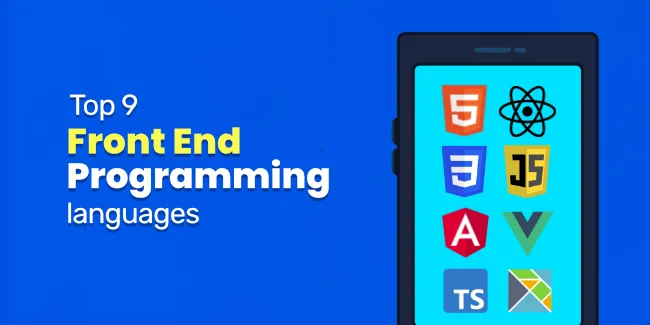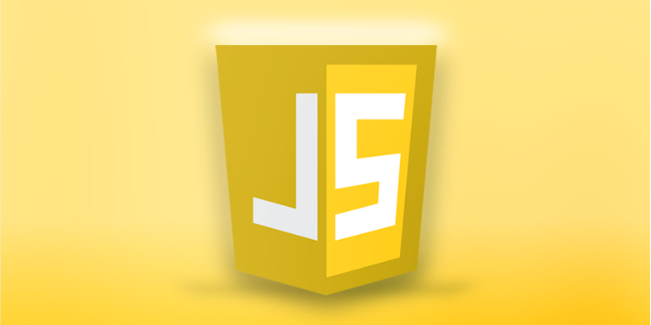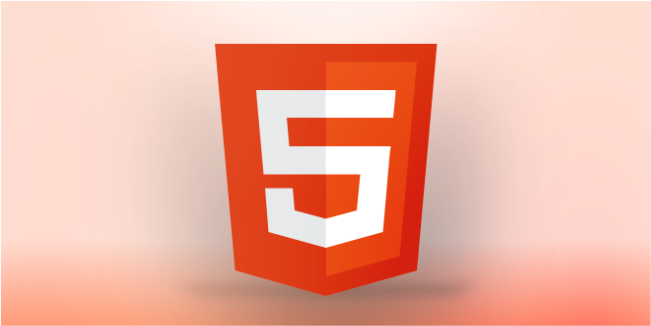development
mobileapp
frontend
programming
languages
Top 9 Front End Programming Languages in 2022

One of the essential features of developing user-friendly applications for mobile and web platforms is front end development.
There are many front end development languages right now, each with its benefits and drawbacks. This post will give you a curated list of front end programming languages. It looks at ten of the most popular front end web development languages.
Even if you're a novice, you should have learned that web development incorporates front end and back end languages, which programmers use to build a well-functioning website or web application.
What is Front End Programming Language?
The front end of a website or software program is the part of the system that allows users to execute basic tasks. Users can access different elements and features when visiting an app or browser.
The front end of any site or application is where the programming that enables certain features for users is found. In contrast, a back end requires data processing and fundamental back-end functions to keep the app operational.
Use of Different Programming Languages
The technologies used in front end programming languages include Hypertext Markup Language (HTML), JavaScript, and Cascading Style Sheets (CSS), among other things. A database is a storage location that may be found in just about any software package.
A server contains the site's information, and a back end developer handles databases. While end-users do not directly connect to the back end of a website, they indirectly influence front end developers' decisions by using various front end applications.
Back end development is server-side and entails keeping and organizing data and ensuring that front end programming languages execute correctly. These two layers work together to produce a dynamic website that allows visitors to make purchases, fill out contact forms, and interact with the site in other ways while they are browsing. In comparison, Full Stack development covers the full range of web development.
Importance of Front end Development
The major benefit of front end development is that it may be completed more quickly. Front end development has advanced technologically, with cutting-edge tools and methodologies accessible.
Creating a front end for an already established back end application is quick and easy. As a result, generating the end product takes significantly less time. Consequently, experienced developers rarely face difficulties in developing completely functional front ends.
Creating Powerful Feelings
The web page is typically a company's first impression and initial connection with clients in an increasingly web-based world. When developing a solid front end development language strategy, website designers must keep this in mind.
The web pages cannot catch the user's attention on their own. It must appeal to the sort of consumer the firm wants to attract, and it must deliver precisely what these consumers need right away. It similarly impacts the business as a first impression reflects its image.
Customer Trust
Even if a well-defined development strategy yields a user-friendly, appealing web experience, it will not be enough to help a firm unless it also conveys the real objective of the business. Customers should not be perplexed by the appearance and design of a website.
Instead, they should immediately connect with it and discover what they can do with it. In a market where attention spans are continually shrinking, using HTML, JavaScript, and other programming languages to create this quick yet powerful message is essential.
Ease of Navigation
Your web page navigation system should be simple so visitors can find what they're looking for. This site has a sophisticated design and stunning visuals that make it appealing and well-organized. Furthermore, front end development improves the commercial advantages of businesses. Users will have an easy time navigating as a result of this combination. It will also enhance customer confidence.
The List of 9 Best Front End Languages
When writing the front end of your website or program, there are a few popular best front end development languages for you to select from and their advantages.
JavaScript

JavaScript is a widely-used programming language that allows users to create complex features on web pages.
It can be activated when a web page performs a dynamic action, such as delivering periodic content updates, animated two-dimensional and three-dimensional graphics, interactive maps, video boxes, and more.
JavaScript is an object-oriented programming language similar to Visual Basic. JavaScript has concepts that are built around the notion of objects. Polymorphism, for example, allows an object to be taken in many shapes by using object-centered languages.
Users may use a client or browser to read and interact with websites. A user's web browser may be referred to as a client, which the user uses. After data from a server has been uploaded by a client, it is accessed by a user who has rendered it.
Users can begin client interactions by filling out a webpage form. Form validation, also known as user verification, validates users' input to initiate client connections. The client must validate the information given by a user to confirm it is correct.
Pros:
Server load - JavaScript is a client-side programming language that may be utilized to reduce server requirements on the fly. Server requirements for some programs may even be zero.
Simplicity - JavaScript may be utilized to create features like drag and drop capabilities for sliders. It can significantly enhance the user experience on a website.
Additional Functionality - JavaScript developers can extend a web page's functionality by adding JavaScript snippets for various third-party add-ons.
Cons:
Browser Support - JavaScript can be interpreted differently based on the browser's interpretation. As a result, creating cross-browser code can be challenging for some developers.
Client-side security – JavaScript code is frequently executed on a user's computer, often resulting in security concerns due to harmful activities. It's why many developers disable JavaScript.
Hypertext Markup Language (HTML)

HTML, which stands for Hypertext Markup Language and is an acronym for Hypertext Transport Protocol, is a language for producing electronic documents known as web pages. Every page has multiple connections to hyperlinks or other web pages.
HTML is the most widely utilized type of markup on the Internet. It's used for all web pages, both commercial and non-commercial. Browsers must be able to display texts and load additional components to function properly.
The HTML programming language has a simple learning curve and is highly user-friendly. The language is platform-independent as well. Wotnot helps you add videos, pictures, and sound files to your website. HTML makes it simple to include video, image, and audio material on a website. The language can also embed hypertext material within paragraphs of text. Html is a simple markup language in comparison to other languages.
Pros:
Easy to learn and use - HTML is one of the most simple-to-understand programming languages, according to most developers.HTML is frequently the first language taught to code beginners. It is an essential component of every development course.
Free - HTML is free language developers do not need to purchase the software. The language does not rely on external plugins or programs to deliver essential features.
Browser Support - HTML is the most popular website format, and virtually all modern web browsers support it. As a result, there's no need to worry about browser compatibility if a website is written in HTML. HTML sites may be optimized for the various browsers from which they can be loaded.
Cons:
Lack of Dynamism - Using simple HTML isn't enough to deliver many of today's websites' features to their users. It might be challenging for developers to integrate dynamic material into web pages with HTML. They must also know additional languages like JavaScript, PHP, or ASP to add dynamic content.
Little Content – Using HTML to display an appealing arrangement of material is also not a good idea. It is a limitation that most developers are aware of. To make HTML page content more appealing to the eye, they must rely on CSS or Cascading Style Sheets in some cases. Web designers and builders are sometimes required to build and maintain two separate file sets.
CSS

CSS is a programming language that describes how documents should be presented to users in terms of layout and style. A document is commonly defined as a text file structure using a markup language such as HTML, widely used XML, or SVG.
The method is to include CSS as an intermediary platform for text-to-speech. It is particularly significant for browsers like Chrome, Firefox, and Edge, designed to graphically deliver documents to screens, printers, and projectors.
CSS selectors are used to pick and altering various web page parts. They may be referred to like structural elements for matching attribute names and values. Selectors can now target pseudo-classes to style URL-targeted elements. Selectors also include a checked pseudo-class for styling checked components, such as radio buttons and checkboxes.
The CSS3 features included in templates like Google Analytics by Parse can be used to make different modifications, such as text justification change, document whitespace adjustment, and word hyphenation style. CSS includes properties that help improve the visual effect by adjusting character spacing and placing drop caps at the start of paragraphs.
Pros:
Time-saving - CSS is a language that allows you to modify the appearance of text, images, and other elements on your website. Depending on demand, a style can be assigned to each HTML element and applied to multiple web pages. CSS code must be written once and may be used on any HTML pages.
Easy to maintain - A successfully installed theme has simple CSS code to maintain, allowing users to modify the style quickly. All online pages are automatically updated after adjustments are made.
Changing web standards - The HTML meta tags are no longer widespread use, and more people are turning to CSS. It is suggested that developers implement it across HTML documents to guarantee future browser compatibility.
Cons:
Cross-browser problems - Developers may find creating CSS changes on a website simple. However, after the modifications have been implemented, there is the need to make sure that all browsers display them in the same way. It's essential to monitor across browsers because CSS capabilities vary from one browser to another.
Multiple levels lead to confusion – CSS is an ambitious language with a bewildering number of levels. CSS, CSS 2, and CSS 3 are the three primary levels, each with its own rules.
React

React is a JavaScript library that allows you to design user interfaces in a fast and cutting-edge way. It's presently one of the most popular JavaScript libraries for constructing the web from ends, and it's a fantastic choice for overall application development.
React is a powerful tool for building visual user interfaces and browser data rendering. React makes front end web development quick and easy, so see what it has to offer in terms of fundamentals and benefits.
Pros:
Easy to learn - React is a simple programming language to understand and use, owing to its extensive documentation, online training resources, and instructional videos. JavaScript developers familiar with React will have no difficulty absorbing the material.
Great features - One of the most significant advantages of React is the use of a special kind of virtual DOM. Developers can optimize the structure to get optimum performance when an app is focused on user interactions and has regular data updates.
Cons:
Dynamic technology - ReactJS is a popular choice for development, but it's constantly evolving. It sets higher standards for developers who must invest time and effort learning new updates.
Poor documentation – With each release, some developers have trouble keeping up with the frequent updates in React documentation and tools. It is challenging to update oneself if the most recent manuals are not accessible for specific devices, causing production delays.
AngularJS

It is a front end programming language developed by Google and is known as AngularJS. In contrast to other languages, it is more difficult and sophisticated.
AngularJS is a web application framework that offers developers a primary yet adaptable platform for building numberless applications. With the ability to create visually appealing web designs and incorporate functionality, it's no surprise that this lightweight JavaScript library has become increasingly popular. AngularJS' popularity stems mainly from its scalability, which allows for the rapid development of various kinds of apps.
Although its intricacy is overlooked owing to its benefits, AngularJS offers a variety of ready-to-install extensions that can save time and simplify the development process.
Developers can create comparable experiences to apps by utilizing cutting-edge platform capabilities. Angular has high performance and is simple to set up.
You may use the command-line tools in Angular to develop apps quicker, add tests, and get them up and running quickly.
Pros:
Functionality - The default Angular configuration has a wealth of utilities for newcomers to get started with. Routing requirements can be addressed using some of these tools. It may be used to retrieve an app's needed data. Angular's preconfigured environment helps to speed up both development and testing.
Consistency - Angular is a comprehensive and responsive web designing framework compared to React. Developers can find it easy to develop services, components, and modules.
Cons:
Limited SEO options - Users of the Angular framework may experience difficulties because of the fewer SEO choices and lack of crawlability by search engines.
To complicated – Angular may be difficult for some developers to comprehend, negatively influencing the project's success. Even the newest versions of Angular are complex for some people.
Vue.js

Are you searching for a basic and straightforward best front end development language? If this describes you, Vue.js is the answer. There's nothing Vue.js can't do, as its name suggests: it may produce smooth and engaging web pages and single-page web applications.
The most popular front end development language is a versatile and quick solution for small to medium websites.
This programming language is popular among low-budget web developers searching for a cheap, budget-friendly option. Vue.js isn't only approachable because of its price but also perfect for beginners working in front-end development.
It is due to its simplicity and ability to be learned in a short amount of time. All you need is a basic understanding of programming and HTML to utilize Vue.js.
Pros:
Functionality - The default Angular configuration has a wealth of utilities for newcomers to get started with. Routing requirements can be addressed using some of these tools. It may be used to retrieve an app's needed data. Angular's preconfigured environment helps to speed up both development and testing.
Consistency - Angular is a comprehensive and responsive web designing framework compared to React. Developers can find it easy to develop services, components, and modules.
Cons:
Limited SEO options - Users of the Angular framework may experience difficulties because of the fewer SEO choices and lack of crawlability by search engines.
To complicated – Angular may be difficult for some developers to comprehend, negatively influencing the project's success. Even the newest versions of Angular are too complex for some people.
TypeScript

TypeScript is a language that's used to write front end code. It's another front-end development type that works in tandem with JavaScript and is TypeScript. It can extend the functionality of the JavaScript support tools for applications across various browsers.
This leading front end development language is object-oriented and more targeted for web pages with greater detail and specificity. When compared to JavaScript, TypeScript has a similar user experience. Expect clear and familiar syntax when it comes to TypeScript.
A feature of TypeScript that sets it apart from JavaScript is the ability to simplify coding and debug code more efficiently. This front end development language is easier to understand and read, making it an excellent choice for beginners wanting to start their front end development career.
Pros:
Direct typing – In TypeScript, elements that have been defined in a certain manner retain their initial values. It is one of the most critical features of TypeScript.
Structural typing – Users who want to define used structures need access to structural typing. TypeScript makes it easier for developers to exploit well-known structures.
Type annotations – Users may use type annotations in TypeScript to document the type they want to utilize.
Cons:
Hard to master – TypeScript requires high effort for code implementation.
Documentation problem – TypeScript requires a definition document for using an outsider library, and this document may not always be accessible.
Elm

Elm is a relatively new best front end development language, having been launched in 2015. If you're a front-end developer wanting to build a quick website with few breaking bugs, Elm is the language for you. Working with JavaScript if you're a back-end developer looking to develop an online shop that converts quickly
Elm allows users to build client-facing applications without the drawbacks seen in HTML and CSS thanks to its architecture, which is based on Redux. Whether you're developing websites or web apps, Elm enables you to do so with high-quality and easy tooling.
For the needs of developers, Elm provides simple functions, inputs, and outputs. For any given function input, users may expect a predictable output. Code debugging becomes easier. Its users can define interfaces using functional programming features. They can add a reactive cycle through user action updates.
Pros:
Simplicity – Elm is a simple language to learn, and development experts may readily access numerous tutorials, instructions, FAQs, and other resources and a helpful developer community. Developers may use an ever-increasing number of tools to their advantage.
Good project support – Elm is well-known for providing simple project assistance due to compilator warnings. The alerts prevent any modifications that an application cannot compile. It results in lower project expenses.
Cons:
Restrictive – Some developers may find that Elm feels limiting, especially if they are accustomed to dynamic languages such as JavaScript or Ruby.
Poor support – Users are reduced to a few functions. There is no support for individuals or loops, and users must make do with what's available. Modifying the value of a nested structure inside another structure can be difficult since the original value cannot be changed.
JQuery

The popularity of JQuery is on the decline, having once been a popular and favorite front-end development language. JQuery is a JavaScript library that allows users to code less and create cleaner sites. This front end development language is simple to learn and suitable for newcomers in the sector since it can reduce programming complexity.
JQuery was once preferred above JavaScript because of its simplicity and user-friendliness. Making it a more friendly and more accessible option. It's also a disposable component.
This front end development language may allow users to write one line of code to program and build software.
Pros:
Future-proof – jQuery enables JavaScript improvement without developers having to learn fresh syntax.
Simple code – Code can be simple, readable, and reusable with jQuery. Also, the need for writing complex and repetitive loops and DOM library calls is reduced with the language.
Cons:
Limited functionality – Even with a large library of options, JavaScript power can be limited. When the demand for customization increases, developers need to rely on JavaScript instead of jQuery.
JQuery javascript needed – The JQuery JavaScript file is required for performing JQuery commands. Despite its tiny size, this file is a concern for both a client computer and web server when the need arises to host jQuery scripts on the server.
Conclusion
When selecting a front-end development language for your next project, knowing which languages are ideal for your project may be beneficial.
Each front end website developer will use a distinct development language, thanks to the many advantages and distinctions each has.
Whether it's JavaScript framework or CSS, trying each language to see which one is best for you is essential.